You have no items in your quote list.
- Home
- Antique Damchiya Bridal Dowry Chest with Four Distinct Iron Locks
Details
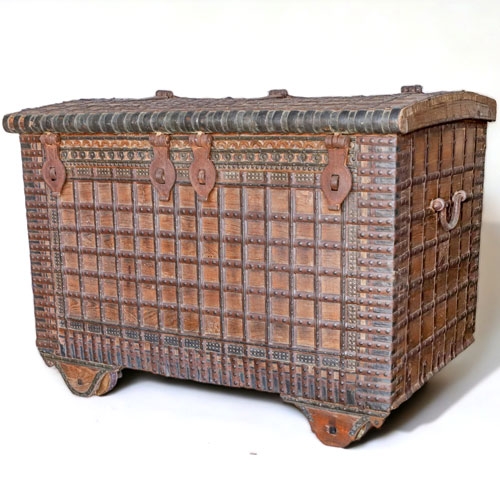
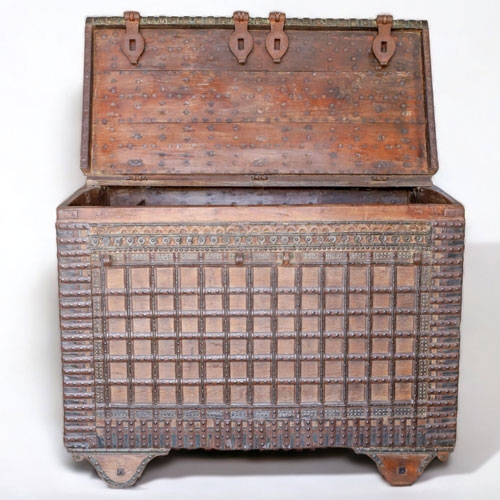
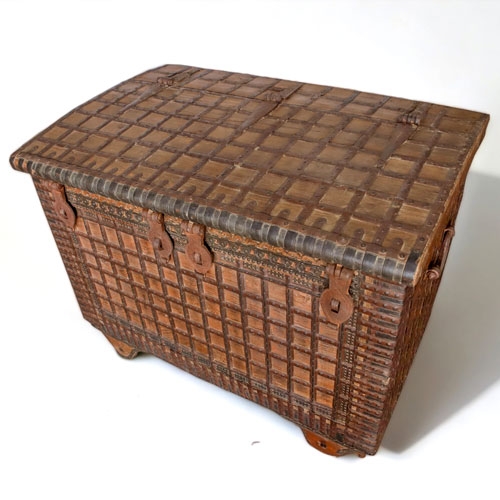
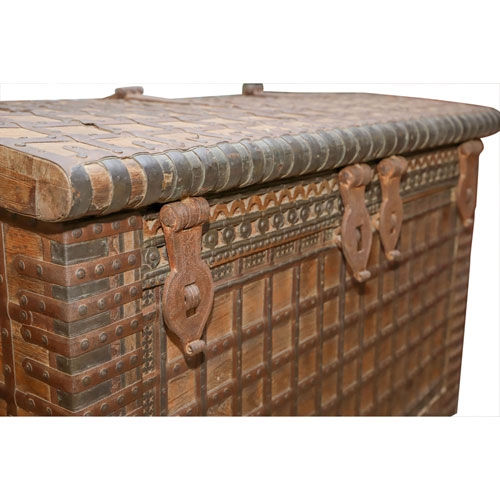
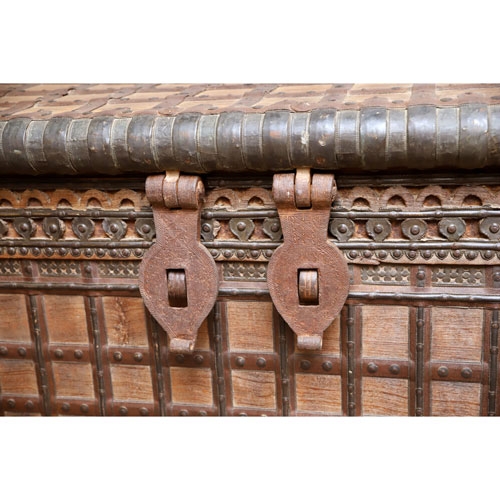
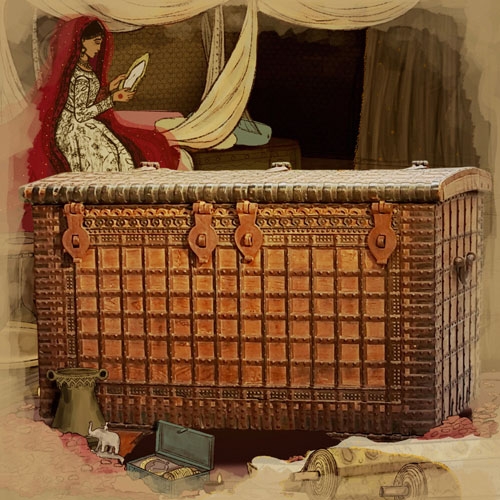
This unique Damchiya also referred to as a dowry chest, with four distinctive, imposing iron locks, circa 1890, is a standalone exquisite feature piece of furniture. These dowry chests were presented to a bride at the time of her marriage, by her parent’s household. it would have been used to store valuables, jewelry, linen, silverware, glassware, kitchenware, or any other such article that was considered valuable by the societal parameters of the period.
Alongside the four locks, the attention to detail draws your eyes toward the iron straps that cover the chest entirely. The handles and hinges are heavy and ornate, and the wheels have been carefully camouflaged from view at the front and are exposed at the back. Also referred to as a Hope chest, damchiya, sandook, majju, or pataaro is said to have, originated due to the Portuguese influence in India. History suggests that the Portuguese sailor’s chest served as the inspiration for these dowry chests.
The craftsmen of ancient or medieval India were not interested in the creation of furniture. While they were famous for their skill and technique in creating ships, palaces, doors, wooden sculptures, carvings, etc., we hardly find any mention of them creating any household furniture other than those ceremonial in nature.
By no means does it signify that Indians lacked knowledge of furniture-making. Varahamihira, in the 6th century CE, mentions fourteen species of wood ideal for making furniture, in accordance with their properties. Shilpashastras find mentions of sixty-four techniques detailing the art of cutting, seasoning, and crafting wood. There are sculptures depicting religious or spiritual figures seated in asanas (elevated seats). The art and skill existed, but furniture-making was not in vogue.
Furniture like charpai (cot), pidha (a small wooden stool for sitting), and mooda (a type of wooden chair for sitting), etc. do find mention in various texts, but their presence was minimal, and there is no significant record of their history or importance. Most of the activities of Indians, like sleeping, sitting, eating, etc., were floor-oriented; hence, dhurris and carpets played an important role in the household.
The arrival of the Mughals had a significant influence on the creation of household furniture in India. During their time, writing desks, tables, etc. with decorations of ivory, carvings in gold or silver, and the use of dark wood and mirrors became prominent in most parts of northern India. The development of furniture in India is mostly of recent origin, most notably with the advent of European colonisation. The European colonisers introduced India to Western furniture, which then began to be produced in India with indigenous materials.
Wood was the primary raw material required to construct a dowry chest. Usually, hardwood such as teak, mahogany, rosewood, walnut, or any other hardwood that could be acquired locally was used. These woods were able to provide a strong and sturdy structure to the chest to withhold weight.
Traditionally, in India, the women of the house would embroider linen or any other textiles along with accumulating valuables from the birth of a girl child, which could later be given to her as dowry at the time of her marriage. Even young girls would have used the chest as a storage place for any item they may find important or valuable, and that could be taken with them as dowry after their marriage.
The families that had limited means used to collect and save articles of value in this chest, which was then presented as a dowry at the time of the wedding. The prosperous families, along with collecting and saving the valuable articles, used to commission a special dowry chest to be presented at the wedding.
The dowry cabinet was constructed to be of varied sizes and designs. The chests could be hollow from the inside or have different compartments made for housing different objects. The appearance of the chest carried great importance as it signified the wealth and status of the bride’s family. Most of the dowry chests were fully sculpted, but the design, decoration, and painting depended on the region. These chests were beautifully carved, painted, or uniquely decorated, and although there were guidelines for the decoration of the dowry chest, the owner could exercise the right to specify the carvings and ornamentations according to his or her wishes. Often, a chest contained hidden latches, secret compartments, and openings that were accessible only to the bride. Up to fifteen secret compartments could be constructed in a dowry chest. Mostly, every household had a personal suthar (carpenter) who was tasked with creating the dowry chest. Only the suthar and his successor, along with the owner of the chest, were aware of the complex mechanism of the hidden compartments of the chest, which were confided in the bride at the time of her marriage.
If the dowry chest was to be passed on to a daughter by her mother, the knowledge of the secret compartments was passed on to the daughter at the time of her marriage. Other members of the house and other descendants did not know these hidden compartments and their functioning, leading to the possibility of a large fortune being lost at the sudden demise of the owner of the chest.
Most of the chests, instead of being placed on the ground, rested over two pairs of legs to protect the chest from dampness, termites, or rodents. However, nails were not used to combine the different parts of the chest but were “stitched together” with the help of a wooden pivot to complete the structure.
The chest in itself carried as much importance as the dowry and was usually ornamented with carvings or paintings. The doors and panels of the dowry chests were decorated uniquely. These dowry chests were richly decorated with geometrical and floral patterns or symbols of good luck (like Lord Ganesha or Swastika). The colors mostly used for painting these chests included red (which signifies purity), yellow (which signifies happiness), and blue (which signifies determination).
Apart from the regional presence and variations of the dowry chests, the popular kind of dowry chests, which were even exported from India, were classified into four main types
Shirazi (Persian) Chest - Originating in Persia (now Iran), these chests were made of teak and were considered to be of the finest quality and exceptionally rare to find. The chests were decorated with plated brass with intricate flower designs on them. It lacked any central design, and the minimal decoration on the front left much of the wood in view.
Surat Chest - Named after Surat, a city in Gujarat, these teakwood chests were similar to Shirazi chests in design but varied in decoration. Surat's chests are plated with heavy brass work on the front, covering almost the entire entirety of this design, leaving very little room for showing the wood.
Bombay Chests - Named after Bombay (now Mumbai), a city in Maharashtra, these chests are made of teak
Malabar Chests - Named after the southwestern coast of India, these chests are made of rosewood, easily recognized by the scanty brass work inlaid on the front.
Additional Information
| Size | No |
|---|---|
| Height | No |
Wow Rentals is a South East based specialised event furniture hire company , we have a wide range of furniture at great prices. We supply within London as well as the East, South East & Midlands.
Add the Wow Factor to your events, contact us to meet your contemporary event furniture needs. We cater for all types of events from corporates to smaller events
Wow Rentals
Our Favorites
Artificial Tree Hire
Like us for updates
Wow London T/A Wow Rentals, 10 Harland Ave, Croydon, CR0 5QB. All Prices are Ex-Vat. Company number: 09056521 Contact Us

